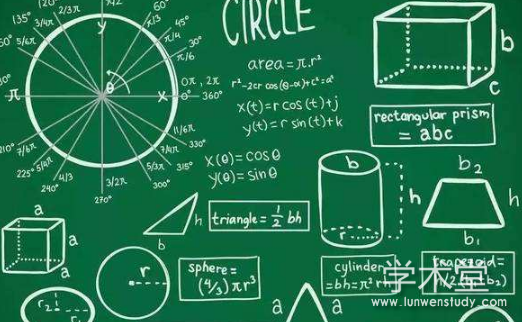数学教育硕士论文(最新6篇)之第一篇:数学建模在高考数学中的应用分析
摘 要
随着信息时代的飞速前进,数学建模的应用价值逐渐受到人们的普遍重视,这也对数学学科教学和学习产生了冲击,所谓上层建筑是由经济基础所控制的,当今经济社会的发展带来的社会需求使得数学学科的教育不能仅仅停留在理论和知识的学习,更要注重提升学生运用理论知识解决现实性难题的能力.数学建模作为数学学科应用型试题的载体,对数学应用型试题的重视就意味着对数学建模的重视.在 2017 年发布的《高中数学课程标准》中指明了数学六大核心素养包含数学建模,这也是第一次在官方文件中强调数学建模对于学生学习数学学科知识的重要性,与此同时,该文件在为高考题命制的提议中明确指出:需要有相应的试题题型以及水平划分考查学生是否具备所要求的数学建模素养.可见数学建模由此开始要真正融入到高中课堂中,甚至是高考试题中,因此本文对数学建模在高考数学中的应用的分析是有意义的。
首先,本文通过对当前数学建模所处背景和研究现状的详细阐述和说明,指明当前该课题有研究价值的方向,以及文章所具有的理论意义和现实意义;通过对文献中关于建模及建模思想的相关概念理解和分析,对其给出新的看法和观点,总结归纳定义,并给出本文研究所具备的理论基础。
其次,本文对建模类题目在高考数学中所考查的考题进行分析,以 2014—2018 年各省高考数学试卷为研究对象,分别从试题类型和试题特征两部分分析,列出在高考试题中七大常见模型:函数模型、线性规划模型、三角模型、排列组合模型、概率模型、回归分析模型、几何模型等,再对其进行逐个分析,给出例题展示并指出学生对该试题完成解答后所具备的数学建模素养水平,随后将七大模型中所占的数量和分值通过图示和表格的形式进行呈现,针对各个图示和表格所呈现的数据进行分析,依据分析结论对高考数学中有关数学建模试题的命制趋势进行预测。
最后,给出提高学生解决数学建模问题能力的策略,这里包括教师的积极引导策略,即通过教师重视课堂教学活动,不仅是概念教学活动还有解题教学活动来更好地渗透建模思想,还要积极组织课外建模活动,强化学生的建模意识,并针对不同的问题总结出相应的建模方法,提高学生的建模能力;此外还包括学生的自我培养策略,即通过重视学习数学基础知识,提升自身理解问题的能力;积极参与建模活动,加强交流合作;在做题时注意理论联系实际,提高数学建模素养.本研究期望能通过对高考数学中有关数学建模试题的分析,让读者明白建模试题的命题方式和考查的知识点的范围,为学生更好地解决高考数学中的数学建模问题,提高解题速度增加正确率,培养学生的建模素养,提高学生解决建模能力等方面提供一些思考和帮助.
关键词:数学建模,高考数学,应用分析

ABSTRACT
With the rapid advancement of the information age, the application value of mathematical modelinghas been paid more and more attention, which also has an impact on the teaching and learning ofmathematics.The so-called superstructure is controlled by the economic basis.The social needs brought bythe development of today's economy and society make the education of mathematics not only stay in thestudy of theory and knowledge, but also pay attention to the promotion of learning.The ability of studentsto use theoretical knowledge to solve practical problems.Mathematical modeling, as the carrier of appliedquestions in mathematics, means the importance of mathematical modeling.The six core qualities ofmathematics, including mathematical modeling, were pointed out in the "Mathematics CurriculumStandards for Senior High Schools" published in 2017.This is the first time that mathematical modeling isemphasized in official documents for learning.At the same time, the document clearly points out in theproposals for the system of college entrance examination questions that the students need to have thecorresponding test questions and the level division to check whether they have the required mathematicalmodeling literacy.It can be seen that the mathematical modeling begins to be really integrated into the highschool classroom, even in the college entrance examination questions.Therefore, this paper presents themathematical modeling in the college entrance examination.The analysis of the application of mathematicsis meaningful
Firstly, through the detailed elaboration and description of the background and current researchsituation of current mathematical modeling.this paper points out the direction of current research value ofthis topic, as well as the theoretical and practical significance of the article; through the understanding andanalysis of the related concepts of modeling and modeling thought in the literature, it gives new views andviewpoints, summarizes and defines them, and gives the theoretical basis of the research this paper
Secondly, this paper makes an analysis of the mathematic examination questions in the collegeentrance examination.Taking the mathematic examination papers of each province from 2014 to 2018 asthe research object, this paper analyses the types and characteristics of the examination questions, and lists seven common models in the college entrance examination questions: function model, linear programmingmodel, triangle model, permutation and combination model, probability model and regression analysismodel.Then it analyses them one by one, presents examples and points out the students 'mathematicalmodeling literacy level after the completion of the answer to the question.Subsequently, the number andvalue of the seven models are presented in the form of graphs and tables, and the data presented by thegraphs and tables are analyzed.According to the analysis conclusion, the trend of the proposition of themathematical modeling questions in the college entrance examination mathematics is predicted
Finally, the strategies to improve students 'ability to solve mathematical modeling problems are given,which include teachers' active guidance strategies, that are teachers pay attention to classroom teachingactivities, not only concept teaching activities but also problem solving teaching activities to betterpenetrate the idea of modeling, but also actively organize extracurricular modeling activities, strengthenstudents' awareness of modeling, and summarize the corresponding for different problems, Modelingmethod can improve students 'ability of modeling; In addition, it also includes students' self-cultivationstrategies, that is, to enhance their ability to understand problems by attaching importance to learning thebasic knowledge of mathematics; to actively participate in modeling activities and strengthencommunication and cooperation; and to pay attention to integrating theory with practice in problem-solving,so as to improve their mathematical modeling literacy
This research expects to provide some thoughts and help for students to better solve the problem ofmathematical modeling in college entrance examination, improve the speed of solving problems, toincrease the correct rate, cultivate students' modeling literacy, and improve their ability of solving modelingproblems by analyzing the mathematical modeling questions in college entrance examination, so as to makereaders understand the way of proposing the mathematical modeling questions and the scope of theknowledge points examined
KEY WORDS: Mathematical modeling, Mathematics in college entrance examination, Applicationanalysis
目 录
第一章 绪论
1.1 研究背景
在当今这个科技迅猛发展,大数据盛行的时代,人们对于数学知识的掌握必不可少,无论是在新兴科技产业,还是在社会大众的日常生活中,数学知识的重要作用都渗透其中,广大群众对于数学本身所附有的独特贡献价值逐渐予以认同.当然数学的地位能够攀升的如此之高,必然也离不开许多具备优秀数学文化素养的学者以及研究人员对数学发展的贡献,而要想真正的构建一栋牢固的、坚不可摧的数学大厦,需要的是具有更多有着无私奉献、敢为人先的精神的高层次数学知识人才.当今随着诸多大学学府对学科专业化发展重视度的提高,对于教师究竟要如何教数学、学生究竟要如何学数学等等诸多人们遇到的难题也成为教育界领导者当下引导学术界积极探索的话题,在数学教育领域诸多学者十分关注培育学生自身有关数学方面的应用意识和实践能力,但是体现数学应用最典型的课程就是数学建模,而究竟怎样培养拥有数学建模思想的高素质人才呢?
就当前研究分析给出的结论指出其关键在于改变中等数学教育以往的单纯考查学生做题能力的应试化模式,但是只仅仅针对高中教学模式进行改革,而不改变对教学方式起着主导作用的高考的试题题型,那可以说一切都是徒劳的.因此抓住其主要矛盾改变高考是尤其重要的,只有高考试题重视考查中学生掌握数学建模思想的能力,才能引起教师在教学中重视教学生学会用建模思想解决难题,由此我们国家才能真正选拔出合适的、杰出的人才服务于社会,才能促使社会不断地向前迈进,所以对于当下抓紧对高考试题的研究,尤其是对建模思想试题的研究显得刻不容缓.而对于数学高考题型中,最能体现数学建模的题型无非就是应用类试题,而这类试题多数是以现实题材为背景编制的,这也是现阶段能较好检验出学习者数学建模能力高低的主要题型.而依据新课标中的指导思想能够直接有效反映数学建模思想的应用题将成为高考考查的重点知识,这也不得不引起我们对它的重视.在《普通高中数学课程标准(2017 年版)》(以下简称《新课标》)中提出要以学生达到的数学学科核心素养层次作为实现数学学科目标的评判标准,其检验的主要过程则是在高中数学学习过程中以考试和考查的形式呈现,而在这其中与数学有关的核心素养是由数学抽象、逻辑推理、数学建模、直观想象、数学运算和数据分析等六个方面组成的,这六大内容包含了学生应具备的有关数学方面的基本素质。
在这里所提及到的数学建模第一次单独在大众面前出现.此外,在指定高中数学课程的结构时也将数学建模活动与数学探究活动作为主线纳入其中,贯穿在必须牢固掌握的课程,可选择性牢固掌握的课程以及理解性课程之中,学分的设置也将 B 类科目中的模型作为其中一个专题并设置为 1 学分;与此同时,《新课标》在对于高考的命题建议中指出数学高考题应命制一定数量的与常识相符,贴切生活实际并能检验出学生在解决问题时将理论应用于实践的能力,突显举一反三的新颖思维的应用问题.在考题命制过程有关注意环节中,要求构造基于数学学科核心素养水平检验的评价体系,这个体系包含三个维度,其中第二个维度中就涵盖了数学建模活动与数学探究活动.而在编制高考试题时,也是基于这三个维度之上展开的,并且每道题目需给出重点考查方向,除了延续以往的评分模式,还需参考相关数学学科核心素养的水平划分依据给予评判;高考数学考试大纲(以 2018 年出版的为例)中针对所要考核内容从知识、能力、个性品质等三个方面提出要求,其中在能力要求中指出应加强对学生应用意识方面进行考查,而此处提出的应用意识则指的是在熟练掌握数学知识的基础上运用相关理论解决现实社会中有关生产、生活及其他方方面面所遇到的简单问题,并能针对问题相关背景,信息材料加以归类、整合,使实际问题转化成用数学语言表述的问题从而进以分析解决,最后运用数学思想方法进行检验.对于应用的过程则是根据实际情景,抽取数量关系,建立数学相关模型加以解决。
这也对应《新课标》中所提到的数学建模方面的要求.而对于考查学生数学建模思想的题型则主要通过结合应用类题型进行综合展现,因此现今是有必要系统地研究数学建模在高考数学中的应用分析.
【由于本篇文章为硕士论文,如需全文请点击底部下载全文链接】
1.2 研究内容
1.3 研究目的
1.4 研究意义
1.4.1 理论意义
1.4.2 实用价值
1.5 研究方法
第二章 文献综述
2.1 相关概念界定
2.1.1 模型与数学模型
2.1.2 数学建模
2.1.3 数学建模素养
2.2 数学建模研究的理论基础
2.2.1 建构主义学习理论
2.2.2 弗莱登塔尔的教育思想
2.2.3 班杜拉的社会认知理论和自我效能理论
2.3 国内外研究现状
2.3.1 国外研究现状
2.3.2 国内研究现状
第三章 高考数学中数学建模试题分析
3.1 体现数学建模的高考数学试题的类型分析
3.1.1 函数模型
3.1.2 线性规划模型
3.1.3 三角模型
3.1.4 排列组合模型
3.1.5 概率模型
3.1.6 回归方程、统计模型
3.1.7 几何模型
3.2 体现数学建模的高考数学试题的特征分析
3.2.1 不同模型试题的考查频率
3.2.2 不同形式试题的考查频率
3.2.3 不同年份试题的考查频率
3.2.4 数学模型考查的 SOLO 水平情况统计(以函数模型为例)
3.3 高考数学中有关数学建模试题的命制趋势预测
第四章 提高学生解决数学建模问题能力的策略
4.1 教师的引导策略
4.1.1 重视课堂教学,渗透建模思想
4.1.2 组织建模活动,强化建模意识
4.1.3 总结建模方法,提高学生建模能力
4.2 学生的自我培养策略
4.2.1 重视学习数学基础知识,提升自身理解问题的能力
4.2.2 积极参与建模活动,加强交流合作
4.2.3 理论联系实际,提高数学建模素养
第五章 结语
5.1 研究结论
5.2 感悟与反思
参考文献
致 谢
| 数学教育硕士论文(最新6篇) | |
| 第一篇:数学建模在高考数学中的应用分析 | 第二篇:高中数学教学中学生创新思维培养现状 |
| 第三篇:激励教育在数学教学中的应用研究 | 第四篇:数学文化在小学数学教学中的渗透研究 |
| 第五篇:新课标下中学数学翻转课堂模式研究 | 第六篇:中学数学教学中3D打印课程的应用 |
第一章教育网络舆情及应对概述近年来,教育网络舆情爆发频率较高,纷繁复杂的突发事件将部分学校卷入到安全和声誉的危机之中。古语云:三人成虎,众口铄金。这也意味着,人的语言和报纸、电视、互联网等媒介组成的传播世界对公众了解事实真相起到了决定性...
第2章过度教育概念释义及相关概念辨析2.1核心概念释义2.1.1度的哲学含义。哲学意义上,度,是标志事物质和量统一的哲学范畴,是事物保持其质的稳定性的量的限度、幅度.?度也是被规定保持自己的质的量的范围,度本身是一种量,并且是一种限量。度作为限量...
与西方发达国家相比,我国科学教育发展相对滞后,且一直没有得到足够的重视。1904 年,“癸卯学制”出台以后,我国逐渐把专门培养“高精尖”科技人才的科学教育转变成培养国民科学素养的基础教育。...
第三章中小学教育网络舆情应对现状及存在问题根据中小学教育网络舆情的特点,笔者认为中小学教育网络舆情应对工作的主体应由教育行政部门和学校两部分组成,两者密切配合,从宏观和微观两个层面切实提高应对效果。一.中小学教育网络舆情应对的现状(一...
第二章邯郸市学前教育概况一、概况随着幼儿教育在儿童发展中的重要性日益凸显,近年来,我国幼儿教育在实践中得到了迅速发展。邯郸是河北省第三大城市,位于河北省南部地区,是国务院批准具有地方立法权的18个较大城市、主城区人口超百万的特大城市之...
结语马云在谈及互联网对实体销售的冲击时指出,实体销售之所以变成今天这种局面原因在于对互联网的无视态度,很多人在互联网成长的初期,第一看不见它,第二看不起它,之后随着网络的迅速发展,在想赶超时已是为时已晚,就会出现后来的第三看不懂和第四来不...
第四章对拜泉县中小学音乐教育的管理方向思考21世纪是知识型人才需求的时代,也是人才全面发展的时期。中国社会主义现代化建设要求中小学在培养学生时必须提升学生的音乐素质,进而影响学生发散性思维的培养。同时,我国教育部在关于音乐的新课改(《普通...
本研究所采用的研究方法为文献法、问卷调查法。首先,收集并梳理文献后对教育戏剧进行概念界定,在相关理论基础上阐述了教育戏剧在小学语文教学中的价值、应用原则及应用策略。...
第四章关于邯郸市幼儿教育发展的思考和建议心理学研究表明,幼儿期是身心发展的敏感期或最佳发展期,错过了最佳发展期,不仅对个人、对家庭、对民族甚至对整个国家都将是不可估量的损失。但是要使人们对幼儿教育重要性的教育真正落实到实践中,还可能受到...
第二章赏识教育的概述(一)赏识教育的内涵及特点:赏识教育,通俗的一点的解释是对学生的赞赏,对学生的长处的肯定。为了让学生在学习过程中有更好的积极性,教师对其有别于其他人的长处、闪光点给与肯定,让其对自己的学习充满信心。从而会影响他整个身...